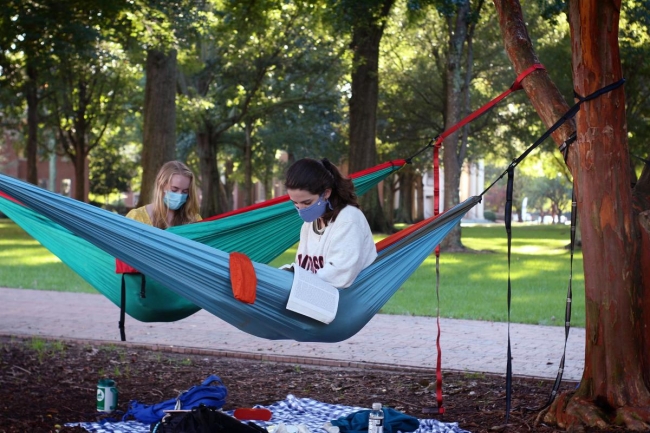You have /5 articles left.
Sign up for a free account or log in.

Students study in hammocks at Davidson College.
Courtesy of Sydney Schertz
Davidson College students awoke Friday to unexpected but welcome news: they would have the day off.
“No classes, labs, discussion sections, no practices. No mandatory activities. Relax and catch your breath,” Davidson vice president for student life Byron McCrae and president Carol Quillen wrote in an email to students at midnight Friday. “The pandemic is still with us. So, stay close to campus, wear a mask, stay six feet apart, and wash your hands. No gatherings.”
In a typical year, a spur-of-the-moment day off for students is not news. But Davidson’s announcement comes as many colleges cancel fall and spring breaks in an effort to curb student travel and thus minimize the spread of COVID-19.
Student travel contributed to the spread of COVID-19 last spring, research shows. A May study by research economist Daniel Mangrum and Ball State University economics professor Paul Niekamp revealed that counties with students who had early spring breaks -- and likely traveled and returned to campus before spring campus closures -- had higher subsequent COVID-19 case counts than counties with fewer early spring breakers. The increase in case growth rates peaked two weeks after students returned to campus after their break, the study shows.
This fall, the prevailing wisdom is that once on campus, students should not travel. Many colleges adjusted their academic calendars to cut out break times and end the semester around Thanksgiving. Dr. Anthony Fauci, director of the National Institute of Allergy and Infectious Diseases and adviser to the Trump administration, said in early September that sending college students home after they’ve arrived on campus was “the worst thing you could do” to quell an outbreak.
Chris Marsicano, assistant professor of the practice in educational studies at Davidson, was part of a team that put out pre-print research on how colleges reopening for face-to-face instruction are associated with subsequent increases in local virus transmission rates. But he praised the colleges’ day off decision on Twitter. (This paragraph has been updated to correct the topic of Marsicano's research.)
“Any time a campus facilitates movement of its students, the disease has an easier pathway to spread, and breaks make it easier for students to go away for the weekend,” Marsicano tweeted Friday. “This is why so many schools chose to forgo a Fall Break and end the semester at Thanksgiving.”
Marsicano supported the day-off decision for two reasons: students are visibly exhausted, and the college made the break a surprise.
Faculty "received an email from President Quillen at 6:00 PM ET detailing the reasoning for the break and swearing us all to secrecy so that it could be a surprise for the students," Marsicano wrote in an email. "Carol’s email was clear -- the reason for this break is that students are burnt out. Sitting in front of a Zoom screen all day, with little opportunity for in-person socializing, is exhausting."
The break was intended to be a surprise, Jay Pfeifer, director of media relations, said in an email. He said that leadership made the decision to give students a break after receiving consistent feedback that they would welcome one.
Marsicano expects more institutions to run with the surprise break idea. He pointed to several New England liberal arts colleges, such as Smith College and Wellesley College, which have in the past announced unexpected days off -- called Mountain Days -- as a fun surprise for students.
Davidson has so far prevented a COVID-19 outbreak on campus. Only one student has recently tested positive for the virus, and the college’s positivity rate is less than 1 percent. The small private North Carolina college, which enrolls about 1,800 students, is testing all its students every week.
"To keep students safe a college has to control movement on and off campus, build student buy-in to COVID-19 countermeasures and test everyone all the time," Marsicano wrote. "Davidson has testing down pat -- every student is tested at least once a week. We also have a high level of student buy-in and social cohesion on campus. But fatigue and burnout may crack the foundation of that student buy-in."
Students were certainly glad for the day off.
“Best. Email. Ever,” tweeted Madeline Buitendorp, a student at Davidson. “There is actual cheering up and down my hall right now after learning we have a day off.”
“[Thank you] queen we are so happy,” Rachel Wren, also a Davidson student, said to Quillen on Twitter.
Students spent the day attending online open mic nights and outdoor musical performances and playing spike ball, Pfeifer said.








